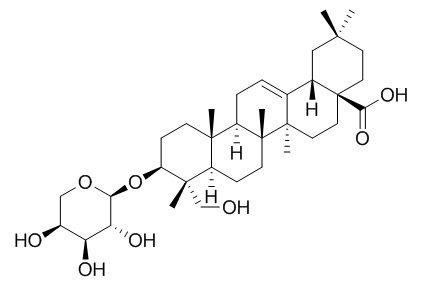Cauloside A
Cauloside A exhibits concentration- and time-dependent mitochondriotoxic activities.
Inquire / Order:
manager@chemfaces.com
Technical Inquiries:
service@chemfaces.com
Tel:
+86-27-84237783
Fax:
+86-27-84254680
Address:
1 Building, No. 83, CheCheng Rd., Wuhan Economic and Technological Development Zone, Wuhan, Hubei 430056, PRC
Providing storage is as stated on the product vial and the vial is kept tightly sealed, the product can be stored for up to
24 months(2-8C).
Wherever possible, you should prepare and use solutions on the same day. However, if you need to make up stock solutions in advance, we recommend that you store the solution as aliquots in tightly sealed vials at -20C. Generally, these will be useable for up to two weeks. Before use, and prior to opening the vial we recommend that you allow your product to equilibrate to room temperature for at least 1 hour.
Need more advice on solubility, usage and handling? Please email to: service@chemfaces.com
The packaging of the product may have turned upside down during transportation, resulting in the natural compounds adhering to the neck or cap of the vial. take the vial out of its packaging and gently shake to let the compounds fall to the bottom of the vial. for liquid products, centrifuge at 200-500 RPM to gather the liquid at the bottom of the vial. try to avoid loss or contamination during handling.
Int J Mol Sci.2021, 22(19):10405.
J Drug Delivery Science and Tech.2022, 67:102957.
J Korean Med Obes Res.2023, 23:10-7
Molecular & Cellular Toxicology2017, 13(3):271-278
RSC Adv.2024, 14(40):29319-29329.
Cell Physiol Biochem.2017, 44(4):1381-1395
Toxicol Rep.2021, 8:1131-1142.
J Ethnopharmacol.2018, 210:88-94
Sci Rep. 2018, 10590
Phytomedicine.2018, 38:45-56
Related and Featured Products
J Nat Prod. 2014 Jan 24;77(1):111-7.
Toxins in botanical dietary supplements: blue cohosh components disrupt cellular respiration and mitochondrial membrane potential.[Pubmed:
24328138 ]
Certain botanical dietary supplements have been associated with idiosyncratic organ-specific toxicity. Similar toxicological events, caused by drug-induced mitochondrial dysfunction, have forced the withdrawal or U.S. FDA "black box" warnings of major pharmaceuticals.
METHODS AND RESULTS:
To assess the potential mitochondrial liability of botanical dietary supplements, extracts from 352 authenticated plant samples used in traditional Chinese, Ayurvedic, and Western herbal medicine were evaluated for the ability to disrupt cellular respiration. Blue cohosh (Caulophyllum thalictroides) methanol extract exhibited mitochondriotoxic activity. Used by some U.S. midwives to help induce labor, blue cohosh has been associated with perinatal stroke, acute myocardial infarction, congestive heart failure, multiple organ injury, and neonatal shock. The potential link between mitochondrial disruption and idiosyncratic herbal intoxication prompted further examination. The C. thalictroides methanol extract and three saponins, Cauloside A (1), saponin PE (2), and cauloside C (3), exhibited concentration- and time-dependent mitochondriotoxic activities. Upon treatment, cell respiration rate rapidly increased and then dramatically decreased within minutes.
CONCLUSIONS:
Mechanistic studies revealed that C. thalictroides constituents impair mitochondrial function by disrupting membrane integrity. These studies provide a potential etiological link between this mitochondria-sensitive form of cytotoxicity and idiosyncratic organ damage.
Zhong Yao Cai. 2012 Nov;35(11):1789-92.
Chemical constituents of Dipsacus asper.[Pubmed:
23627090]
To study the chemical constituents of Dipsacus asper.
METHODS AND RESULTS:
Column chromatography on Silica gel and RP-C18 were applied for isolation and purification of the constituents. Their structures were identified by spectral and chemical methods.
From the crude MeOH fraction of Dipsacus asper, 12 compounds were isolated and identified as Sucrose (1), beta-sitosterol (2), Oleanic acid (3), Triplostoside A (4), Loganin (5), Loganin acid (6), Sweroside (7), Epi-vogeloside ( 8), Vogeloside (9), Akebiasaponin D(10), Cauloside A(11),7-Deoxyloganic acid (12).
CONCLUSIONS:
Compounds 8, 9, 12 are isolated from this plant for the first time.



